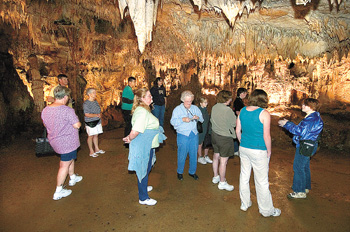
© Michael ReillyBats from Endless Caverns are being tested for white-nose syndrome.
Samples of bats found in the Endless Caverns show cave and suspected of having the deadly white-nose syndrome have been sent to a federal testing facility, the Virginia Department of Game and Inland Fisheries confirmed Friday.
If the tests come back positive, it will be the first confirmed case in Rockingham County of the mysterious disease that has wiped out hundreds of thousands of bats in the Northeast. The disease showed up in Virginia for the first time earlier this year, but until now, no bats in the central Valley had been suspected of having the illness.
White-nose syndrome is named for the ring of white fungus that typically appears on infected bats' snouts, and sometimes on other body parts such as wings.
Besides the fungus, infected bats typically have low body fat, are dehydrated and demonstrate abnormal behavior, such as searching for food during the winter.
Rick Reynolds, a wildlife biologist with the VDGIF, said Virginia Cave Board members discovered bats showing signs of the disease during a tour of Endless Caverns on Saturday. Endless Caverns is a commercial show cave located near New Market. The caverns, along with several similar caves in the central Valley, are a popular tourist attraction.
Reynolds visited the caverns on Tuesday to take samples of the bats, which he sent to the U.S. Geological Survey's National Wildlife Health Center in Madison, Wisconsin, to be tested. The results should come back in two to three weeks, he said.
The bats in Endless Caverns "were probably in the very early stages of showing the fungus," Reynolds said. "It was not as prominent as some of the pictures that you see. It was just kind of spotty on the wings."
Endless Caverns Still OpenNo one was available at Endless Caverns on Friday to talk about the suspected case, but Reynolds said officials there have been cooperative and are taking steps to prevent spreading the disease. Biologists suspect that white-nose syndrome may be caused in part by human activity in the caves and mines where bats live and hibernate.
Endless Caverns officials are adding an educational component to their tour, alerting people to the fact that bats in the cave may have white-nose syndrome, he said.
They also are setting up a station where guests can sanitize their footwear after touring the caverns, and they are encouraging visitors to shower and wash their clothes before entering another cave, Reynolds said.
"Most of those people probably go into one cave and that's it. ... That type of caver is not really going to spread it," he said. "We have not asked [Endless Caverns' officials] to change their operations."
In addition to Endless Caverns, state biologists recently found suspected cases of white-nose syndrome in bats in Bland and Cumberland counties, Reynolds said.
Biologists discovered bats in a cave in Bland County this past weekend that showed signs of the disease, and they returned to the cave on Friday to take samples of the bats.
In Cumberland County, a single bat on the side of a building showed signs of the disease and biologists sent the animal to be tested about a week ago, Reynolds said.
He added that it's not clear where that bat came from because Cumberland County doesn't have caves. VDGIF is working with the Department of Mines and Minerals to determine whether the bat came from one of the county's mines, he said.
Cause Of Disease UnclearThe first cases of white-nose syndrome in Virginia were confirmed earlier this month in Breathing Cave in Bath County and Clover Hollow Cave in Giles County.
At that time, VDGIF officials began asking caving enthusiasts to stay out of caves and it closed caves in its management areas in hopes of slowing the spread of the disease that has scientists baffled.
Biologists say they don't know what's causing the syndrome, exactly how it's spread or how to stop it from infecting more bats, which, in most cases, are naturally disease resilient.
Biologists say they are not surprised by these new suspected cases.
"It probably means what we expected all along, that it's going to grow and develop over time," Reynolds said. "As time moves on, we're just going to find more counties with the disease showing up ... unless we get a handle on it."
First Case In New YorkThe country's first cases of white-nose syndrome were identified about three years ago in bats in several caves near Albany, New York
Since then, the disease has been confirmed in other parts of New York as well as the neighboring states of Vermont, Massachusetts, Connecticut and Pennsylvania. It also has been confirmed in New Hampshire, New Jersey, and just recently, West Virginia and Virginia.
The disease has wiped out 75 to 90 percent of the bat population in New York and more than 400,000 bats in the region, records show.
Reduced bat populations could be detrimental for many reasons, including the fact that bats eat many insects, such as cucumber beetles and corn borer moths, which can ruin crops.
Reader Comments
to our Newsletter